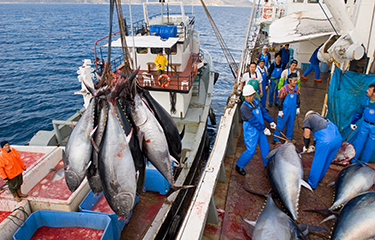Wild-capture fisheries and marine and brackish aquaculture operations in the Mediterranean and Black seas produced close to 2 million metric tons (MT) of seafood in 2021, according to a new report from the Food and Agriculture Organization’s (FAO) General Fisheries Commission for the Mediterranean (GFCM).
The report, “The State of Mediterranean and Black Sea Fisheries (SoMFi) 2023,” found that these activities collectively generated USD 20.5 billion (EUR 19 billion) in revenue and supported 700,000 jobs throughout the seafood value chain.
This year’s SoMFi report included data on the region’s aquaculture for the first time, and calculated the sector increased its production in volume by 91.3 percent over the last decade to around 870,000 MT, with revenue rising 74.5 percent over that period to USD 12.7 billion (USD 11.8 billion).
GFCM Executive Secretary Miguel Bernal specifically highlighted that the region’s fisheries contribute more jobs, but aquaculture operations now generate more revenue.
“Capture fisheries production has been declining since the 1990s due to the reduced biomass in key commercial species but also more recently due to restrictive measures taken to ensure sustainability,” Bernal said. “Opposite to fisheries, aquaculture is clearly on a growth [trend], with both production and revenues nearly doubling in the last decade.”
The three main farmed production methods in the region are marine cages, ponds, and suspended culture, while the most commonly farmed species are gilthead seabream (281,914 MT in 2021), European sea bass (272,096 MT), and Mediterranean mussels (86,117 MT). Turkey (314,408 MT), Egypt (137,202 MT), and Greece (135,318 MT) were the three largest regional producers, together accounting for 71 percent of 2021’s total volume.
Greece’s Hellenic Aquaculture Producers Organization (HAPO) Director of Communications and Public Relations Ismini Bogdanou said the report’s findings suggest that aquaculture is “successfully responding with reliable consistency” to the increasing global demand for high-quality protein, adding that consumers now perceive seafood as a more environmentally friendly and sustainable protein option.
“The rise of aquaculture is a positive indicator of economic opportunities within the industry,” she said. “As production increases, so does the potential for job creation and economic growth, bringing financial benefits for all parties involved.”
According to Bogdanou, aquaculture’s rising figures indicate “now is the time for action” to ensure aquaculture can continue to grow in a sustainable way. In this regard, climate change presents the biggest challenge in the Mediterranean and Black seas, she said.
“The best way to ensure aquaculture can continue growing in a sustainable way is successful adaptation to the ‘new reality,’ ensuring that regulations and voices governing aquaculture are adapted to the climate crisis and that they are well-defined, fair, and conducive to industry growth going forward,” Bogdanou said.
Another one of SoMFi’s key findings is that in 2021, overfishing in the region fell to …
Photo courtesy of zaferkizilkaya/Shutterstock








